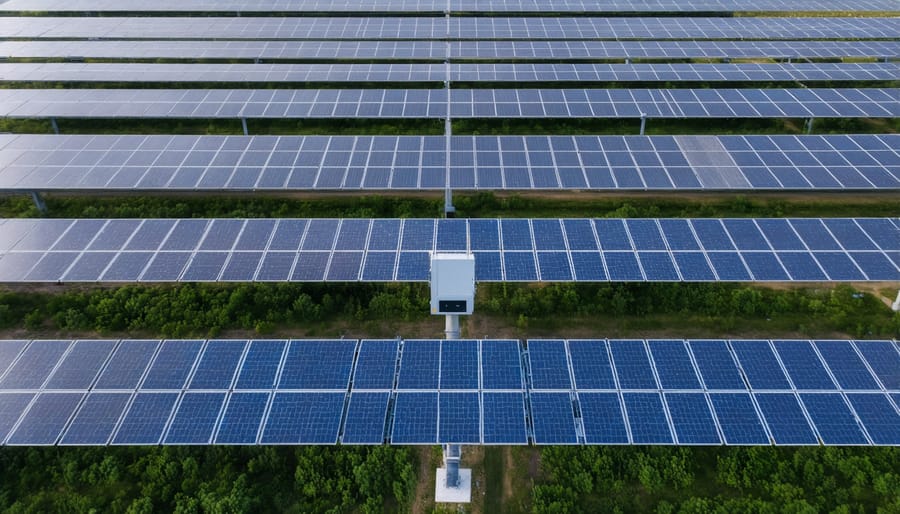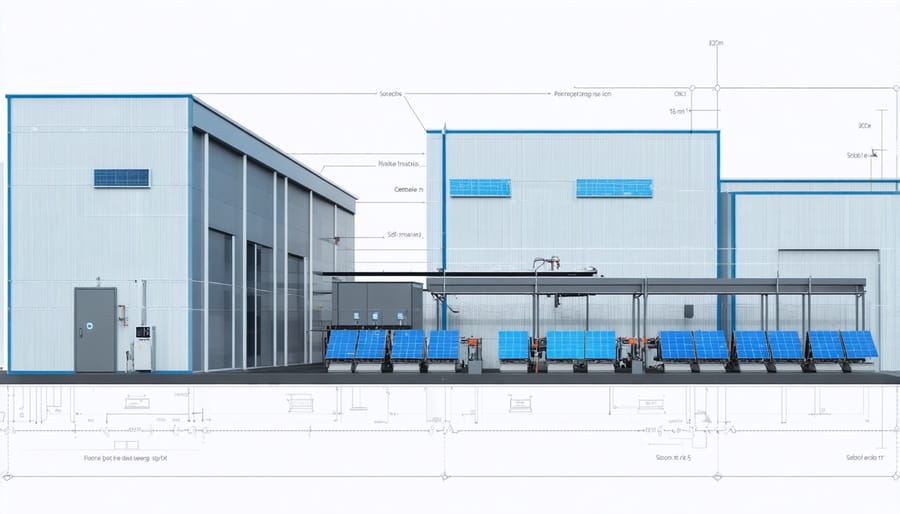Smart Solar Grid Integration That Actually Works (European Success Stories)

Transform Europe’s energy landscape by mastering the integration of solar power systems through strategic grid management and innovative storage solutions. Modern solar strategies extend far beyond simple panel installation, encompassing sophisticated load balancing, smart grid technologies, and dynamic energy trading platforms that maximize return on investment while ensuring grid stability.
The evolution of solar integration in European markets demands a dual focus: optimizing technical performance through advanced monitoring systems and maximizing economic benefits via strategic deployment timing. Leading utilities and industrial facilities across the continent are already demonstrating how intelligent solar strategies can reduce operational costs by 30-40% while maintaining reliable power supply during peak demand periods.
As renewable energy targets become increasingly ambitious across the EU, implementing robust solar strategies has emerged as a critical success factor for businesses and grid operators alike. These strategies combine cutting-edge hardware solutions with sophisticated software platforms, creating resilient energy systems that adapt to varying weather conditions and demand fluctuations in real-time.
This comprehensive approach to solar integration not only enhances grid reliability but also accelerates Europe’s transition toward a sustainable energy future, offering concrete pathways for organizations to achieve both environmental and economic objectives.
Real-Time Solar Power Management

Smart Inverter Solutions
Modern solar installations rely heavily on smart inverter technologies to maintain grid stability and maximize energy efficiency. These advanced systems go beyond simple DC-to-AC conversion, offering sophisticated grid support functions that enhance the reliability of solar power integration.
Today’s smart inverters incorporate features like voltage regulation, reactive power control, and frequency response capabilities. They can automatically adjust their output parameters to match grid conditions, helping prevent instability issues that traditionally challenged solar adoption. This dynamic response capability is particularly valuable in European markets, where grid standards are increasingly demanding.
These innovative solutions also enable better monitoring and control of solar installations. Through integrated communication protocols, system operators can remotely manage inverter settings, track performance metrics, and respond to grid requirements in real-time. This level of control is essential for maintaining power quality as solar penetration increases across European networks.
For homeowners and businesses, smart inverters provide advanced safety features and improved energy harvest. They can optimize power output under varying conditions, manage energy storage systems, and facilitate seamless integration with home energy management systems. Many models now include built-in monitoring platforms that provide detailed performance analysis and predictive maintenance alerts.
The latest generation of smart inverters also supports grid-forming capabilities, enabling solar installations to help stabilize local networks and potentially operate in island mode during grid disturbances, enhancing energy security for connected facilities.
Grid Balancing Technologies
Grid balancing technologies play a crucial role in maintaining power quality and ensuring reliable integration of solar energy into the European electricity network. These sophisticated systems help manage the inherent variability of solar power production while maintaining grid stability.
Modern load management systems utilise smart inverters and advanced monitoring equipment to regulate power flow between solar installations and the grid. These systems can rapidly respond to fluctuations in both energy production and demand, helping to maintain optimal grid frequency and voltage levels.
Energy storage solutions, particularly battery systems, serve as essential grid-balancing tools. They store excess solar power during peak production periods and release it when needed, effectively smoothing out supply variations. This capability is particularly valuable in regions with high solar penetration rates, such as Germany and Spain.
Power quality control mechanisms, including reactive power compensation and harmonic filtering, ensure that solar-generated electricity meets strict European grid codes. These technologies help prevent issues like voltage sags and power factor deviations that could otherwise compromise grid stability.
Smart grid technologies enhance these balancing capabilities through real-time monitoring and automated response systems. By leveraging artificial intelligence and predictive analytics, these systems can anticipate grid imbalances and initiate corrective measures before issues arise, ensuring seamless integration of solar power into the existing grid infrastructure.
Energy Storage Integration
Battery Storage Systems
Battery storage systems have become a cornerstone of modern solar energy integration, offering crucial solutions for power management and grid stability. These systems enable efficient energy storage during peak production periods and provide reliable power during low-generation times or nightfall.
Lithium-ion batteries dominate the European market, offering high energy density, longer lifespans, and decreasing costs. For residential applications, wall-mounted systems typically range from 5-15 kWh, while commercial installations can extend to several hundred kilowatt-hours. Recent technological advances have improved battery efficiency rates to over 90%, significantly enhancing the economic viability of storage solutions.
Flow batteries represent an emerging alternative, particularly suitable for large-scale industrial applications. These systems offer exceptional longevity and can be scaled more easily than traditional batteries, though they currently come at a higher initial investment. Salt-based batteries are gaining traction in European markets, offering a more sustainable and safer alternative to conventional technologies.
Grid applications of battery storage systems extend beyond simple energy storage. They provide essential services including frequency regulation, voltage support, and peak shaving capabilities. In regions with high renewable energy penetration, such as Germany and Denmark, battery systems help maintain grid stability by smoothing out supply fluctuations.
For optimal performance, modern battery systems incorporate smart management software that predicts consumption patterns and adjusts charging cycles accordingly. This intelligence allows for better integration with time-of-use tariffs and demand response programs, maximising financial returns for system owners while supporting grid resilience.
When selecting a battery storage system, considerations should include capacity requirements, cycle efficiency, warranty terms, and compatibility with existing solar installations. Professional assessment ensures proper sizing and integration with both household consumption patterns and grid requirements.
Hybrid Storage Solutions
Hybrid storage solutions represent a significant advancement in solar energy management, combining different storage technologies to maximize efficiency and reliability. By integrating various storage methods, system operators can leverage the unique advantages of each technology while minimizing their individual limitations.
A typical hybrid setup might combine lithium-ion batteries with hydrogen storage systems. The batteries provide immediate response to power fluctuations and handle daily cycling needs, while hydrogen storage offers long-term seasonal storage capabilities. This complementary approach ensures optimal grid performance throughout the year, regardless of weather conditions or demand variations.
In European markets, we’re seeing innovative combinations such as battery storage paired with pumped hydro facilities. These systems can provide both rapid response times and large-scale storage capacity, essential for regions with high renewable energy penetration. For instance, several Alpine nations have successfully implemented such hybrid solutions, utilizing their natural topography for pumped storage while incorporating modern battery technology for enhanced grid stability.
Thermal storage is increasingly being integrated into these hybrid systems, particularly in industrial applications. By converting excess solar energy into heat and storing it in specialized materials or molten salts, businesses can meet both their electricity and heating needs efficiently.
The key to successful hybrid storage implementation lies in sophisticated energy management systems. These smart controllers optimize the use of different storage technologies based on factors such as energy demand, weather forecasts, and electricity prices. This integrated approach not only improves system reliability but also maximizes return on investment for operators while supporting grid stability.

Digital Grid Management

AI-Powered Grid Control
Artificial intelligence is revolutionising solar grid management across Europe, offering unprecedented control and optimisation capabilities. Modern AI systems analyse vast amounts of data from weather forecasts, consumption patterns, and grid conditions to make real-time decisions that maximise solar energy utilisation.
These intelligent systems predict solar generation with remarkable accuracy, often achieving forecast precision rates above 95% up to 24 hours in advance. This predictive capability enables grid operators to balance supply and demand more effectively, reducing the need for conventional backup power sources and minimising waste.
In countries like Germany and Denmark, AI algorithms are already managing complex grid operations, automatically adjusting power flow based on demand fluctuations and weather conditions. These systems can detect potential issues before they occur, preventing grid instability and ensuring consistent power delivery to consumers.
Smart inverters equipped with AI capabilities can now make autonomous decisions about power distribution, storage, and grid support services. When combined with machine learning algorithms, these systems continuously improve their performance by learning from historical data and actual outcomes.
For European businesses and homeowners, AI-powered grid control translates into more reliable solar power integration, reduced energy costs, and improved return on investment. The technology also supports grid stability during peak demand periods and enables more efficient energy trading in local energy communities.
The implementation of AI in grid control represents a crucial step toward achieving Europe’s renewable energy goals, making solar power more dependable and grid-friendly than ever before.
Remote Monitoring Systems
Modern solar installations benefit significantly from advanced remote monitoring systems, enabling real-time performance tracking and proactive maintenance. These sophisticated platforms collect and analyse data from multiple sensors across the solar installation, providing comprehensive insights into energy production, system health, and potential issues.
European solar operators particularly value these systems for their ability to maximise energy yield while minimising operational costs. Through secure cloud-based platforms, facility managers can monitor key performance indicators, including power output, voltage levels, and environmental conditions, from anywhere with internet access.
The monitoring systems typically feature automated alert mechanisms that notify operators of any anomalies or performance deviations. This predictive approach helps prevent system failures and ensures optimal energy generation. Many platforms also integrate weather forecasting data to predict energy production and adjust system settings accordingly.
For businesses and industrial installations, these systems often include advanced reporting tools that generate detailed performance analytics and compliance documentation. This data-driven approach supports better decision-making and helps demonstrate return on investment to stakeholders.
Modern monitoring solutions also facilitate integration with smart grid systems, enabling better coordination between solar production and grid demands. This capability is particularly valuable in European markets, where grid stability and efficient energy distribution are priorities.
Regular software updates ensure these systems remain current with evolving industry standards and cybersecurity requirements, providing peace of mind for system owners and operators.
European Success Stories
The European solar landscape has witnessed remarkable transformations through several groundbreaking projects that demonstrate the feasibility of large-scale solar integration. In Denmark, the Bornholm Island project stands as a testament to innovative grid management, where a combination of smart grid technologies and advanced storage solutions enables the island to operate on up to 100% renewable energy during optimal conditions.
Spain’s success story comes from the Andalusia region, where the SMARTGRID Málaga project has seamlessly integrated over 300MW of solar capacity through successful microgrid implementations. This initiative has reduced grid congestion by 20% while improving overall system reliability for over 300,000 customers.
Germany’s Wildpoldsried village showcases how community-driven solar initiatives can transform local energy landscapes. The village produces 500% of its electricity needs through renewable sources, with solar contributing significantly to this achievement. Advanced grid management systems and energy storage solutions ensure stable power supply despite variable weather conditions.
In the Netherlands, the PowerMatching City project in Groningen demonstrates how residential solar installations can work in harmony with the grid. The project utilizes innovative demand-response technology, allowing households to automatically adjust their energy consumption based on solar production patterns.
Portugal’s success lies in the Évora InovGrid project, which has revolutionized grid integration through smart metering and automated distribution systems. The project manages over 50MW of distributed solar generation while maintaining grid stability and reducing operational costs by 30%.
These examples highlight common success factors: robust grid infrastructure, smart technology integration, and strong policy support. Each project emphasizes the importance of comprehensive planning, stakeholder engagement, and innovative technical solutions in achieving successful solar grid integration. The lessons learned continue to shape new initiatives across Europe, proving that large-scale solar integration is not just possible but increasingly economical and reliable.
As we look to the future of solar energy integration in Europe, several key strategies have emerged as essential pillars for success. The combination of smart grid technologies, energy storage solutions, and advanced monitoring systems has proven crucial for maximizing solar power utilization. European nations leading in solar adoption have demonstrated that a multi-faceted approach, incorporating both technical and policy measures, yields the most effective results.
The growing trend towards digitalization and automation in solar systems promises even greater efficiency gains. With continued innovations in battery technology and declining installation costs, solar solutions are becoming increasingly accessible to both homeowners and businesses across Europe. The integration of artificial intelligence and machine learning further enhances system performance and predictive maintenance capabilities.
Looking ahead, the outlook for solar strategies remains bright, with emerging technologies and supportive EU policies driving continued growth. Success will depend on maintaining flexibility in approach while focusing on regional specific needs and grid requirements. As the industry matures, these strategies will continue to evolve, ensuring solar power plays an ever-more significant role in Europe’s sustainable energy future.
Leave a Reply